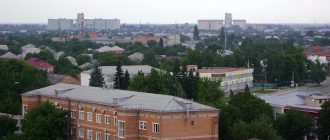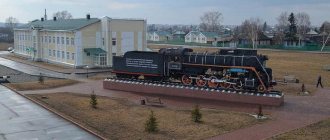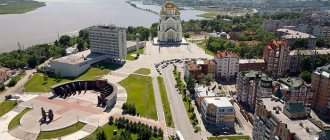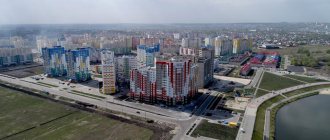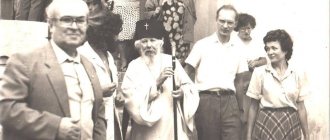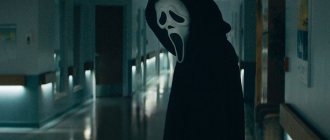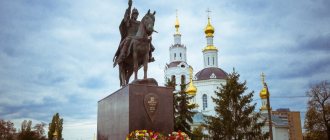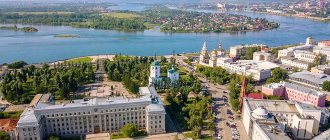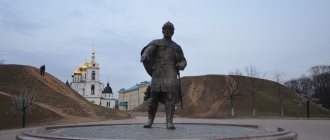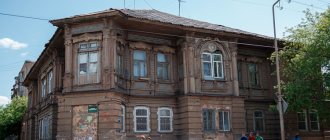- Reports and messages
- Miscellaneous
- Kurgan city
Kurgan is a city founded in 1553, located on the Tobol River and bordering Kazakhstan.
Until the 17th century, it was a military settlement. But in the 18th century, due to shifting state borders, it no longer made sense to station troops here; the city received civil status and its modern name. The population currently is about 350 thousand people. The impetus for the significant economic growth of Kurgan was the construction of the Trans-Siberian Railway through it. The telegraph, telephone, electricity, and cinema began to appear. And after receiving the status of a regional center in 1943, the city began to develop even more rapidly. Currently, Kurgan is a major administrative, cultural, business and industrial center. Kurgan is divided into seven districts: Energetiki, Western, Central, Zaozerny, Ryabkovsky, Northern and Eastern.
The city is known for its industrial enterprises producing military equipment. The city also produces equipment for agriculture and the oil industry, buses, structures for bridge construction, and produces medicines. Medium and small businesses are focused mainly on the food industry and trade. The well-known Ilizarov Center for Orthopedics and Traumatology operates successfully in Kurgan.
Not many architectural monuments have survived in Kurgan. Most of the buildings were blown up during Soviet times. The most important city symbol is the fire tower. Initially it was the building of the Kurgan Fire Department, and now it is an architectural monument. The local history museum is also of historical value, since previously it was the Alexander Nevsky Church, which was built at the very beginning of the twentieth century. In Kurgan, bourgeois and merchant houses of old times have been preserved. It was in this city that many Decembrists served their exile, among whom were V.K. Kuchelbecker, N.V. Bassargin, M.M. Naryshkin.
Option No. 2
Mound. On the banks of the Tobol River in 1553 the city of Kurgan was founded. Until the beginning of the 17th century it was a military city, but the territory of the state grew, and gradually the borders expanded and the city lost its original purpose. It became an ordinary district settlement, which was named Kurgan. And after the Trans-Siberian Railway was built through the city, the city began to grow and develop rapidly. The first settlements here existed before our century. Once upon a time, the leader of the Scythos, a Sarmatian tribe, was buried here, but his grave, like others, was plundered. Currently, the city stands on the graves of the past. Now Kurgan is a large industrial center, with a population of approximately 350 thousand people.
It represents the main center of the entire Urals. The city is divided into seven districts. The city is famous for its medical center where Ilizarov once worked; the center was named in his honor. There are many schools, kindergartens and libraries open in the city. There are places to get higher education. The city of Kurgan is located in the center of Eurasia, in the Ural Mountains, there are no seas or oceans nearby. Thanks to this, the city is cold in winter and hot in summer. There are droughts in the area. One of the symbols of the city is the fire tower; it used to house a fire department; now it is considered a monument. At the top of the tower there is a mannequin, whose name is Grisha, he was a prop for training of young firefighters.
With the Bolsheviks coming to power, two majestic churches were destroyed in the city. Only the Alexander Nevsky Church, which was built at the beginning of the 20th century, survived. Subsequently it became a local history museum. On the streets of the city there are architectural monuments of the 19th century, these include the houses of merchants and townspeople who lived in the city.
The first stone houses appeared in 1860, after a terrible fire in which all the houses were damaged. The city is home to the unique Gagarin Aviation Museum. It contains 14 flying machines, represented by fighter-interceptors, fighter-bombers and many others. To get a better acquaintance with the city and its history, it is worth visiting the Museum of the History of Kurgan, which is located in a merchant mansion. It contains many pre-revolutionary photographs.
The city has twin cities: Rufina (Florence County, Italy) and Appleton (Wisconsin, USA). A house has been opened in the city - a museum of the Decembrists, located in Naryshkin’s house. In it you can learn about the life of the Decembrists in exile.
Climatic conditions
The climate in Kurgan is continental, but heat lovers will find it uncomfortable here. The region has short summers and harsh winters. Snowfalls continue for six months, the average temperature in winter drops to -20 degrees, and on especially cold days it reaches -40. In summer it is no higher than +20, sharp changes are observed. After prolonged heat, severe cold snaps may occur, and vice versa.
There is a wind season in Kurgan , starting in March and lasting almost two months. Due to the unfortunate geographical position, the air stagnates over the area; even eastern currents cannot clear it. Although the city is surrounded by coniferous and birch forests, the atmosphere in it is almost three times dirtier than in neighboring areas.
Most enterprises have switched to natural gas, so they emit fewer harmful substances into the air. There are few roads in the region, their traffic capacity is low, and there are quite a lot of cars.
There are many environmental problems in Kurgan. The Tobol has long become a sewer, and the Black River is also polluted. Local residents scatter garbage on beaches and lakes; spring cleanup days do not allow them to be completely removed.
The environment is deteriorating not only because of the factories; the district administration and city government practically do not care about the cleanliness of the area.
Popular message topics
- Sequoia Tree
The giant pine or sequoia is the largest tree on the planet. Standing next to this tree, a person seems like a dwarf. In ancient times, redwood trees were distributed throughout the northern hemisphere. - Brown algae
The flora of the seas and oceans is extremely diverse! The largest percentage of the biomass of aquatic flora is occupied by algae. According to rough estimates by scientists, more than 100 thousand species of algae have been discovered and studied so far. - Moscow
Moscow is the central city of our country, which is the capital of Russia. This city is not only the capital of Europe, but of the whole world. All tourists strive to get to Moscow in order to see all the beauty that is in our city.
Project on the topic: “Economy of the native land. Kurgan region." for 3rd grade
Project goal: To obtain information about the economy and large industrial enterprises of the region, as part of studying the subject of the world around us.
Make a presentation, prepare a report or message to speak in front of the class. Talk about the industry of the region, its large enterprises, draw a conclusion about the economic potential of the region. Project plan:
- Native land on the map of Russia
- Economic potential
- Sectors of the economy
- Main industrial enterprises
- Pride of the region
- Conclusion
- Sample of a finished presentation
Districts of Kurgan
There are many districts in the Kurgan region. They differ in level of development, population and jobs.
Largest districts:
The remaining 33 have a meager description: they are smaller, consisting of several short streets. The largest is the Central District, it is located next to the Tobol River. It houses the Drama Theatre, the regional administration, a cinema, the Government building, a road and railway station, a children's park, a museum and a large square named after Lenin. If you move towards the river, you can walk to the Old Kurgan, where there are many interesting buildings. They are real architectural monuments.
Shevelevka is considered the most expensive area. This is a clean and cozy settlement, where there is a health complex, a children's railway, and a park of culture and recreation. The complete opposite of this area is Northern. It’s like a separate city, where there are gray panel houses and the private sector. Here you can buy housing quite cheaply.
The Zaozerny district was so named because it is located beyond Lake Chernoe. So far it is considered one of the most beautiful parts of the region. But the population complains about the poor quality of roads and polluted streets. This is the youngest part of the city - its foundation dates back to 1979. Housing here is cheaper than in the Central District.
To the right of Zaozernoye is Ryabkovo. A scientific center named after Ilizarov was built here, where residents of Russia and other countries come for treatment. This area also has a military hospital, oncology and anti-tuberculosis dispensaries, and an infectious diseases hospital.
Vostochny, which has practically merged with Maly Chausov, is characterized by an increased level of crime. Gypsies live here in old private houses, and panel apartments are sold quite cheaply.
The western district is famous for the monument to tankers, the TV tower and the Hypercity building. On Solnechny Boulevard there are beautiful multi-storey buildings surrounded by short alleys.
Workplaces
The machine-building industry is developed in Kurgan. The factories produce URAL, KAMAZ, ZIL, GAZ trucks, and BMP military vehicles. They also produce buses and heavy equipment.
Residents of the city and region receive jobs at various enterprises:
Factories are constantly short of mechanics and turners, so professionals with technical specialties are valued in Kurgan. Women are most often employed in trade and entertainment centers. There are nine supermarkets and more than 30 shopping centers with children's playrooms, cafes, and bowling alleys for city residents.
Population diversity
Since 2007, the birth rate in Kurgan and the region has increased and the mortality rate has decreased. Now more than 326,000 people live in the city, a third of which are children and still disabled youth. According to statistics, there are much fewer male residents than female residents - 149.5 and 184 thousand people, respectively.
Multinational population:
- Russians;
- Ukrainians;
- Belarusians;
- other nationalities and peoples.
Young people from Kurgan and nearby towns are patriotic, get an education and want to achieve a lot. Guys and girls have real views on the world, they freely choose their profession and lifestyle. The administration is committed to ensuring the healthy development of the population. In the Trans-Ural region, sports complexes and a children's and youth center have been built, and work is constantly carried out with students.
The labor exchange provides jobs to the population immediately after reaching adulthood. Although some teenagers can receive a salary on the same basis as their parents, making their contribution to the family budget. Interesting fact: emigration of the population has decreased recently - in 2010, 11 thousand residents left, and in 2015 - only 8,000.
Historical excavation
In the story of the vandal farmer, we are talking about an ancient burial in the Ketovsky district of the Kurgan region. The attacker took out the soil to pour it on his fields. Footage released from the scene shows animal bones at the site of the mound. Now the Investigative Committee of the Investigative Committee for the Kurgan Region is conducting a pre-investigation check on this incident.
The head of the department for the protection of cultural heritage sites of the government of the Kurgan region, Sergei Sevostyanov, told Izvestia that the incident was recorded back in April 2022, and a statement was sent to bring the person who caused harm to the object to criminal responsibility.
Managing partner of Leges Bureau LLC Maria Spiridonova noted that the farmer in this situation committed a crime under Art. 243 of the Criminal Code of the Russian Federation “Destruction or damage to cultural heritage objects.” The fine here is very serious - up to 3 million rubles, compulsory work, forced labor for up to three years, or imprisonment for the same period.
Buried history
Photo: Depositphotos/LehaKoK
Treasure Peninsula: what was found during the construction of the Crimean Bridge
A million antiquities were discovered on an area of 56 hectares
The Department for the Protection of Cultural Heritage Sites reported that the Orlovsky-1 Kurgan burial ground, which was examined during exploration work in 2022, was destroyed. According to preliminary dating, the monument dates back to the early Iron Age (VII century BC - III century AD).
The motivation of the farmer who destroyed the mound is still unclear. However, experts believe that he could not have been unaware of what kind of hill it was on his territory.
“All the locals know that they live near the mounds,” Kurgan archaeologist Igor Novikov explained to Izvestia. “The mound has been plowed by machinery for decades—farmers bypass it when plowing. It is located on a dominant hill. This is a noticeable structure even after two thousand years.
According to him, there are several other mounds nearby, including the largest one in the region, four kilometers away.
Archaeologist Sergei Sirotin also notes that local residents, as a rule, know about the mounds. The exception is plowed places, the presence of which is known only to specialists.
Buried history
Photo: Depositphotos/photographee.eu
Priest, peasants, policeman: in Altai, a pensioner discovered the alleged burial of victims of repression
He took on the search to help a family from St. Petersburg find the grave of their ancestors
“But the fact that it is in the Ketovsky district is obvious that this is a mound,” noted Sirotin. “The farmer understood that he was destroying the mound.

